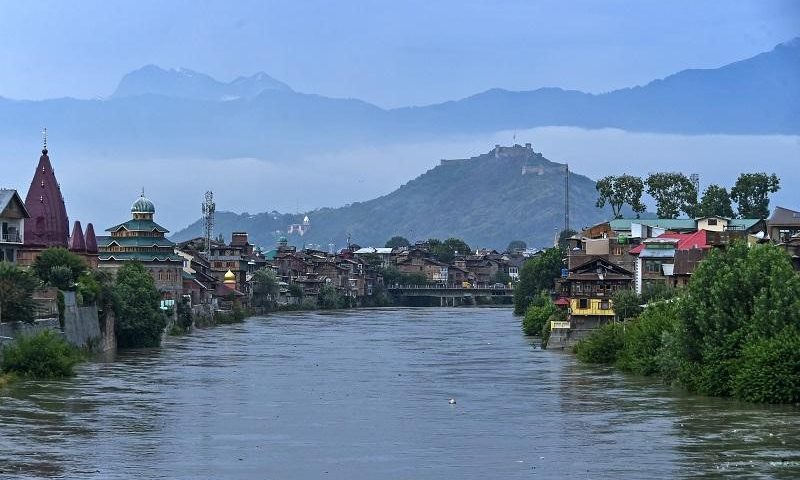Heavy Rainfall Triggers Landslides, Disrupts Traffic Flow on Srinagar-Jammu National Highway
Srinagar: A heavy spell of incessant rain has created havoc in several parts of Kashmir while the Meteorological Department predicted more precipitation during the next 24 hours. Despite assurances from the administration that the water levels are below the danger mark, the continuous downpour led to widespread disruption.
Moderate to heavy rainfall since Sunday evening inundated roads and low-lying areas in Kashmir. Additionally, higher reaches experienced a fresh spell of snowfall, further disrupting normal life and bringing down temperatures. Moderate to heavy rains continued for almost the entire day. The government has chalked out a contingency plan for the city’s low-lying area and selected places in case evacuation needs arise.
Forcast
The latest report by MeT said that moderate rain and thunderstorms are currently affecting most parts of the Kashmir division, while light rain, thunder, and lightning are observed over many parts of the Jammu division. The current spell of rain and thunder is expected to continue intermittently for the next 3 to 5 hours, followed by a gradual decrease thereafter. The residents have been advised to remain cautious as the inclement weather might lead to slippery roads and reduced visibility, impacting travel and outdoor activities.
Advisories
The farmers have been advised to suspend farm operations until Tuesday. Temporary disruption of traffic is expected over higher reaches including Zojila, Sinthan Pass, Mughal Road, and Razdan Pass. Water-logging is possible in low-lying areas and there is a possibility of landslides and shooting stones. A temporary increase in water levels is expected in the River Jhelum, its tributaries, and other local streams and nallas. The adverse weather conditions have forced the closure of key routes, including the Srinagar-Jammu National Highway and Mughal Road. In response to the challenging situation, the administration in north Kashmir suspended classes in many schools to ensure the safety of students and staff. The water level considerably rose in nallahs and streams across Kashmir due to the heavy downpour. However, officials said that there was no threat of floods so far.
Jhelum Gauge
The latest gauge readings at 12:01 on April 30, indicate relatively stable water levels in the River Jhelum and its tributaries in Kashmir. Despite continuous rainfall, the water levels in most locations remained below the danger mark, providing some relief to the authorities and residents.
The gauge reading at Sangam stood at 18.41 feet (below the danger mark of 25 feet); at Pampore at 14.04 feet (below the danger mark of 16:40 feet); at Ram Munshi Bagh at 16.45 feet (below the danger mark of 21 feet); at Asham at 9.76 feet (below the danger mark of 16.5 feet); and Wullar at 1577.24 metres (below the danger mark of 1578 metres).
Tributaries
At 12:01 am on April 30, Vishow Nallah at Khudwani stood at 8.23 meters (below danger mark of 8.50 meters), Rambiyara Nallah in Wachi at 2.03 meters (below danger mark of 5.7 meters), Lidder Nallah in Batkoot at 0.52 meters (below danger mark of 1.65 meters), Doodhganga Nallah in Barzulla at 2.53 meters (below danger mark of 3.8 meters), and Sindh nallah in Doderhama at 2.29 meters (below danger mark of 3.9 meters).
While the water levels have risen slightly, the overall situation remains stable. The administration continues to monitor the situation closely and has advised residents to remain vigilant, especially in low-lying areas. Srinagar, along with other parts of Kashmir, has borne the brunt of the incessant rains, with waterlogging on several roads and low-lying areas. This has severely impacted daily life, with residents facing difficulties in commuting and going about their regular activities.
The authorities have deployed men and machinery along the banks of the River Jhelum in Srinagar and other vulnerable areas across Kashmir to prepare for any potential flooding. This proactive measure comes in response to the heavy spell of incessant rain that has created havoc in several parts of the region.
“The deployment of personnel and equipment is aimed at ensuring swift action in case of a flood threat. The teams are equipped with boats, emergency supplies, and other necessary resources to handle any eventuality,” officials said. “The administration has been closely monitoring the water levels in the River Jhelum and other rivers and streams in Kashmir. Despite assurances that the water levels are currently below the danger mark, the continuous downpour has kept officials on high alert.”
In addition to the deployment of personnel and machinery, the administration has also urged residents living in low-lying areas and along the banks of rivers and streams to remain vigilant and take necessary precautions. The residents have been advised to avoid venturing near water bodies and to follow the instructions issued by the authorities. The India Meteorological Department (IMD) warned of more rain over Jammu and Kashmir on Tuesday.
Meanwhile, fresh snowfall was reported from Bandipora district and the Machil sector of Kupwara in north Kashmir. Some upper reaches including Gulmarg, Gurez Valley, Razdan Top, Sadhna Top, Mughal Road, and Zojila Pass received light snowfall during the past 24 hours. The MeT data showed Srinagar received 38.6 mm of rainfall, Qazigund 64.4 mm, Pahalgam 51.7 mm, Kupwara 40.2 mm, Kokernag 43.6 mm, and Gulmarg 30.2 mm during the past 24 hours.
The maximum temperatures improved but still recorded below normal by 5 to 10 degrees in Kashmir the previous day. Srinagar had a maximum of 16.6 degrees Celsius and it was 6.2 degrees below normal on Sunday, forcing people and tourists to wear warm clothes.
The MeT office said that the minimum temperature recorded on Sunday night in Srinagar was 5.3 degrees Celsius against 8.5 degrees Celsius and 4 degrees below normal. Pahalgam had a low of 7.2 degrees Celsius and Gulmarg minus 1 degree Celsius recorded on Monday, the MeT office said.
Multiple landslides block National Highway
The Srinagar-Jammu National Highway remained blocked for every type of traffic movement due to multiple landslides, triggered by heavy rains, at various places between Banihal and Nashri in the Ramban district on Monday morning. Traffic authorities said, “Following constant rain, fresh mud, landslides and shooting stones hit the National Highway at many places between Nashri and Banihal due to which it (Highway) remained blocked.”
Due to the blockade, hundreds of Light Motor Vehicles (LMVs) and heavy vehicles remained stranded at different locations between Jammu and Srinagar, including Nashri and Banihal sectors. Incessant rains, which lashed the area during the intervening night of April 28 and 29, triggered fresh mud and landslides at Mehar Cafeteria, Mompassi, Ramsu, Kishtwari-Pathar and various other places, in addition to Panthial, resulting in a blockade of the highway. “The movement of vehicular traffic has been stopped since Monday morning. There is no chance of restoration today,” officials said.
Mud and landslides besides boulders and shooting stones at various places on the highway was hampering road restoration work, they said. “Men and machinery have been pressed into service for clearing the mud and landslides’ debris, boulders and stones from the highway but continuous rain is hampering road restoration work,” they said.
Overnight heavy rains have created havoc on the highway at various places between Nashri-Ramban and Ramban-Banihal, damaging roads due to which Kashmir valley remained cut off from the rest of the country, on the second consecutive day on Monday.
Two sub divisions – Banihal, Ramsu also remained cut off from district headquarter Ramban. Some passengers preferred to walk on foot to reach their destinations as the movement of the traffic was strictly stopped by the traffic police on the highway and no vehicle was being allowed to cross Police Naka established in the outskirts of Ramban town by the administration. “We have stopped all types of vehicular traffic as fresh landslides have occurred on the highway at various places between Nahri and Banihal. Shooting stones are rolling down from hillocks on the highway and continuous downpour in the area since Sunday is hampering the road restoration work,” traffic officials said.
The Nashri to Banihal stretch has become prone to landslides and the contractor companies are unable to meet the challenges posed by nature due to unplanned and random earth cutting and excavation in this sector, a few years back.





